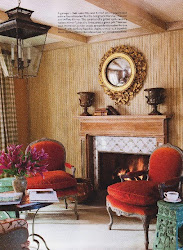These plates, which I painted, are ceramics, not china
(Repost)
This is my plate, It isn't China because it has been fired to a lower temperature
I painted this design on the rim so that it can be seen even if the plate is laden with my favorite meal
So why is our tableware called China?
Dutch Explorers reached China as early as 1596. The Dutch East India Company started to import Chinese porcelain to Holland in 1602.
Every European Monarch, worth his weight in salt, had in his employ an Alchemist with the mandate to produce gold. An 18-year old German Alchemist, by the name of Friederich Boettger, uncovered the secret of how to make hard-paste Porcelain. Boettger had a dubious reputation and was arrested and kept prisoner in Dresden by the order of "Frederick Augustus the Strong", elector of Saxony. Augustus was aware that Boettger was hoping to manufacture gold from base minerals.
Augustus the Strong was also very fond of fine Chinese Porcelain. He traded a regiment of 600 soldiers for 151 pieces of beautiful white china. All along, the 2 Chinese secret ingredients, kaolin and feldspar were fairly abundant and known in Europe. Kaolin powder was used in powdering wigs of the fashionable gentry.
A Dresden scientist, by the name of Ehrenfried Walter von Tschirnhaus, a Prussian Nobleman, had been trying to discover the secret of true Porcelain. Recognizing Boettger's talent, the two joined in a quest, less hopeless than the alchemist's search for gold.
Having discovered the Chinese secret of combining kaolin and feldspar, Boettger in 1708, achieves the first practical formula for porcelain. The first pieces of china are sold at the Leipziger Easter Fair in 1710.
And now you know why your China is called China.
Gina
Gina
All plates painted by Gina























Thats an amazing story. And I absolutely love your large plate with that motif you painted on the edge. Its absolutely beautiful!
ReplyDeleteHi veneeta, thank you for your compliment. By the way, I have been reading your blog "artnlight" for some time. Beautiful!
ReplyDeleteGina
Thank you for sharing why our tableware is called China. I love your dishes.
ReplyDeleteBlessings My Friend,
I love all the plates! Tried to choose a favorite, but it's hard. Probably the gold on the edge, because it stands out so. They're all beautiful, and I can't wait till I can make some for myself so I don't have to covet yours, ha.
ReplyDeleteAs a German I know about 'China' Porcelain, Boettger, Meissen and August dem Starken. But so good to read again!
ReplyDeleteAnd a very good way to explain it to the 'rest of the world'! Short and precise! Well done Gina! We cannot have enough education and history.
Lieben Gruss aus Frankreich,
Karin
Hi Sweet Lady Elaine, Thank you for your visit and lovely comment. Hope you visit again.
ReplyDeleteGina
Hi Jacki, We will definitely paint a few dishes so you can show them off once you get home.
ReplyDeleteDear Karin, The Porcelain story is one of the most fascinating stories. There isso much more to tell. One ofthese daysI will write a post about the "Habaners". They influenced the design for most of central and eastern Europe.
ReplyDeleteGina
Gina, thank you for sharing this. I'm always interested in learning more about ceramics. ~ Sarah
ReplyDeleteHi Sarah, One of these days you will have to come for a visit and we can paint ceramics together.
ReplyDeleteThank you for sharing this. I'm interested to know more about ceramic. I love Chinese porcelain and fond of delftware as well. The blue white colors on delftware are always inspiring. Besides these colors give looks fresh and different. For other collections find at aronson.com/in-depth/the-blue-in-dutch-delftware/
ReplyDeleteHi Amber, You are so right. Blue and white is always so pretty in any setting. Thank you for stopping by.
DeleteThanks for this article very helpful. thanks. green plate set
ReplyDeleteYou are so welcome Elizabeth. Have a wonderful Sunday.
ReplyDeleteInteresting post, thank you for sharing the story of why the tableware is called China, I like the pattern on your plate.
ReplyDeleteHi Marcel, It is an interesting story...the story of our every day dishes. Thank you for your visit.
DeleteDistinct
ReplyDelete